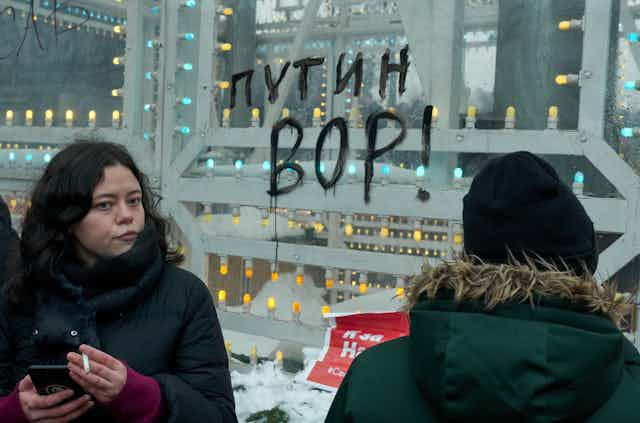Over 3,500 people have been detained during rallies across Russia in protest at high-level corruption and the arrest of opposition activist Alexei Navalny. Navalny was arrested on arrival at Moscow’s Sheremetyevo International Airport on January 17 as he flew in after recovering from being poisoned late last year by the novichok nerve agent.
Navalny is being held in Matrosskaya Tishina, Moscow’s most dreaded jail, charged with violating the parole terms of a suspended sentence for embezzlement. If convicted, he could be sentenced to up to ten years in prison. Navalny has called these charges trumped up, but his recent revelations about Putin’s lavish palace on the shores of the Black Sea won’t have endeared him to the Russian president. Said to feature a helipad, an underground ice palace, a church, a mudroom, a two-floor theatre, several vineyards and a tunnel to provide access to the beach, the home is reported to have cost US$1.35 billion (£988 million).
Read more: Alexei Navalny: Novichok didn't stop Russian opposition leader – but a prison sentence might
Navalny is merely the most prominent activist to allege massive and high-profile corruption in Putin’s Russia. A new generation of journalists is braving imprisonment and physical harm to produce hard-hitting investigations into official wrongdoing, using new digital tools and techniques to uncover their stories. The state corruption their stories reveal is nothing new – it was rife in Soviet times – but since the 1991 collapse of the Soviet Union and the accession to power of the venal Boris Yeltsin, it has been out of control.
Investigative journalism in Russia is a risky business – as Dmitry Muratov, the long-serving editor-of-chief of the prominent investigative weekly Novaya Gazeta, can testify. Muratov has had to bury six of his reporters to date, including, most famously, Anna Politkovskaya, whose reports from the bitter and dirty conflict in Chechnya led to her being shot outside her Moscow home on October 7 2006 (coincidentally, Putin’s birthday).

Novaya Gazeta was founded in 1994 and later received the backing of KGB officer-turned-banker Alexander Lebedev (who part-owns The Independent and the Evening Standard in the UK) and former general secretary Mikhail Gorbachev. The newspaper has been one of the few outlets to defy Putin’s backlash against the media. It has persevered in uncovering links between the Kremlin and political assassinations such as the murder of the opposition politician Boris Nemtsov in 2015.
New breed of reporters
Over the years, Novaya Gazeta has attracted many young journalists brave enough to resist threats and intimidation. Among them are Roman Anin and Olesya Shmagun, who were part of the team that won a Pulitzer Prize for the 2016 Panama Papers investigation. The pair has teamed up to launch Vazhnie Istorii (Important Stories – or, as it is generally known, istories. A non-profit organisation along the lines of the New York-based ProPublica, istories revealed in July that Putin’s former son-in-law, Kirill Shamalov, was able to buy shares worth US$380 million for just US$100. As part of the investigation, istories journalists spent months sifting through a leaked cache of Shamalov’s emails.
Another prominent investigative journalist, Roman Badanin – formerly of Izvestiya, RBC and Gazeta.ru – set up Proekt (The Project) in 2018 with the aim of uncovering corruption and combating disinformation, something he has compared to the samizdat movement in Soviet times where dissidents clandestinely reproduced and shared censored material. Stories The Project has broken an account of police brutality in Ukraine and an investigation into the gambling empire of ice hockey star-turned-politician Vyacheslav Fetisov.
Roman Dobrokhotov, a long-time Putin opponent, took his activism online in 2013, founding The Insider. He won the 2019 European Press Prize Investigative Reporting Award for his four-part investigation into nerve agent attack on Sergei Skripal in Salisbury. More recently, in October 2020, The Insider published a story challenging the official findings of an investigation into a cocaine trafficking ring allegedly involving Russia’s ambassador to Argentina.

One of the things that links and characterises these investigative teams is their mastery of digital media and data to uncover stories. In their efforts to find out who tried to murder Navalny, reporters working for The Insider turned to Russia’s dark net to collect information, such as flight data and telephone records from chemical weapons labs to establish the failed assassins’ identities, all employees of Russia’s security service FSB.
Meanwhile, Proekt traced images, social media networks and WhatsApp messages to investigate the role played by Putin’s former chef, Yevgeny Prigozhin in subsidising the activities of the Wagner Group, a private army that has operated in Ukraine, Syria, Libya and other African countries.
The government’s response has been threefold. Police raids on media outlets’ offices have been combined with undermining their finances by putting pressure on potential advertisers. There has also been blanket dismissal of the reports as “fake news” – which plays well given the public’s tendency to distrust the media and support government censorship of the press.
This raises the question of whether the great risks these investigative journalists take are worth it. If we judge from their direct impact, then the answer is clearly no, but Navalny’s documentary on Putin’s palace has been watched online nearly 100 million times.
Meanwhile, if the Russian public at large is unimpressed, the fact that about a dozen of investigative media outlets are kept going largely through donations and crowdfunding suggests there is a demand from a significant niche readership to see high-level corruption and crimes uncovered and documented.
The documentation of these crimes is of particular importance. Whether or not the officials and oligarchs involved are held to account any time soon, these investigations ensure that detailed information is archived for the future. If there is to be a reckoning, these brave young journalists are providing evidence for the prosecution.

